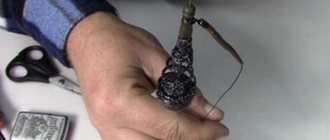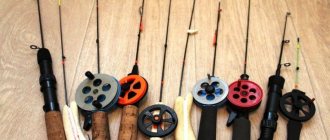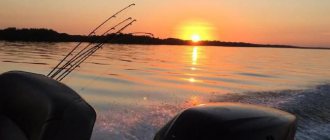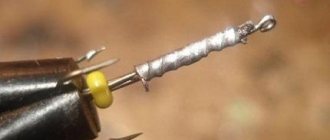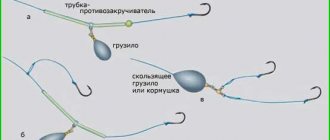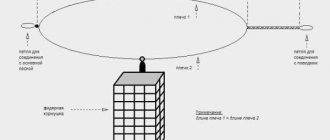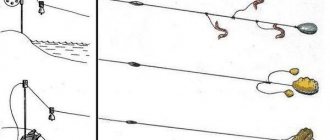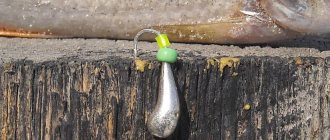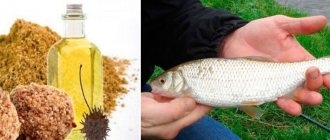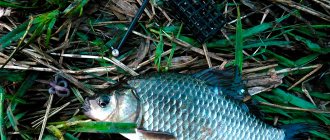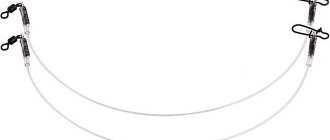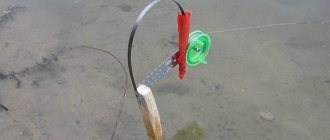A spinning leash is an important element of a set of tackle, without which you cannot count on successful fishing. Even a well-chosen rod, reel, fishing line and lures do not guarantee a bite and effective landing of predatory fish without a good and reliable leash.
In almost any direction of spinning, the use of a leash is necessary. It is needed to perform the following tasks:
- Prevents lures from being cut or torn from contact with predator teeth or underwater obstacles;
- Allows you to make the installation invisible when hunting cautious fish;
- Plays a key role in creating spaced rigs. For example, a leash is needed for a lead leash, Carolina or Texas rigs, split shot and others.
Naturally, depending on the fishing method, a leash is selected from one or another material endowed with special properties and intended for a specific direction. Below we will look at how to attach a leash to a spinning rod, what types they are, and how to make a leash for a spinning rod with your own hands?
Is it required?
Today it is difficult to imagine float equipment without a leash. The leash will save the entire equipment in case of a blind hook , or if a fish of an unexpected size bites. The long leash that the Bolognese fishing rod is equipped with allows the hook and bait to play in the current. A long leash with a sinker used when fishing for bream is designed so that the fish, when taking the bait in its mouth, does not feel any resistance.
Adviсe
- The main advice for beginning spinning fishermen is to gain as much practical experience as possible, actively study bodies of water, and try different techniques and gear.
- During one season , you should not get hung up on one tackle, but try at least 2-3 baits in different conditions.
- With little experience, you should still not skimp, but purchase several leashes of various lengths and types. Since even with the greatest experience, impulses, losses and breakdowns of predators are almost inevitable, the excitement of the fight cannot be delayed, so you should always have spare tackle on hand.
Leash elements
It consists of two required elements: a fishing line and a hook. In some cases, an additional sinker is attached to the leash.
fishing line
The leash line performs the following functions:
- serves as a link between the main line and the hook with bait;
- used for tying a hook;
- acts as a shock absorber when landing fish.
It is customary to use monofilament or fluorocarbon as fishing line for the leash. Monofilament has the following advantages:
- relative invisibility in water;
- high knot strength;
- low price.
Fluorocarbon is practically invisible in water and has no memory , and is also durable because it is resistant to aggressive environmental factors. But its low elongation, which is very valuable in spinning, is rather harmful in float equipment, since the thin line of the leash should soften the jerks of the fish. Fluorocarbon has lower knot strength than monofilament. Additionally, fluorocarbon is quite expensive.
Expert opinion
Knipovich Nikolai Mikhailovich
Zoologist, hydrobiologist. I am interested in fishing at a professional level.
Important! The line for leashes should be chosen carefully. It is necessary to check how much the actual breaking load of the fishing line corresponds to the declared one, how the fishing line holds the knots and look at its shelf life.
In any case, the fishing line for the leash must be of high quality; it is advisable to purchase fishing line from trusted manufacturers.
Hook
The hook must also be of high quality. Its size is determined not by the size of the expected catch, as is commonly thought, but by the size of the bait. For fishing with a float, hooks with an eye and a spatula are used.
What parameters must it meet?
The main parameters of the leash are determined by the following characteristics of the fishing line:
- Breaking load. The breaking load of the leader should always be lower than that of the main line.
- Color. Most anglers use clear line to make leaders because it is the most versatile. But there are those who pay special attention to the color of the fishing line. In such a case, there are the following recommendations:
- very clear water - blue line;
- fishing in the grass - green line;
- fishing on a sandy bottom - yellow line;
- fishing on a pebble bottom - brown line;
- fishing in snags - black line.
- Length. The length of the leash is a very important parameter, which depends on the type of equipment and the fish that is the intended prey.
- for a fly fishing rod – 15-20 centimeters;
- for a plug fishing rod – 10-15 centimeters;
- for match and Bologna rigs - 25-30 centimeters.
Depending on the type of equipment, the length of the leash varies within the following limits:
Depending on the type of fish, the length of the leash is:
- For bleak. A leash 10-15 cm long is quite sufficient, since fishing is carried out in the middle or surface layers of water.
- For roach. Depending on the type of equipment, the length of the leash varies from 15 to 30 centimeters.
- For bream. For bream you need a long leader. If you have to fish in the bottom layer, the leash should be 25-30 centimeters long. Bream are often caught using bait lying motionless on the bottom. In such cases, a small pellet is installed in front of the hook at a distance of 5-10 centimeters, performing the function of a feeder. Having taken the bait in its mouth, the bream does not feel resistance, while the float rises and lies on its side, giving the angler a signal of a bite.
Expert opinion
Knipovich Nikolai Mikhailovich
Zoologist, hydrobiologist. I am interested in fishing at a professional level.
Attention! Monofilament fishing lines can be soft or hard. Rigid fishing line is more suitable for making leashes because it tangles less.
Separately, it is worth mentioning leashes for catching predatory fish using float rigs. To catch perch with fry, fluorocarbon leashes with a single hook are used. To catch pike with live bait, use metal leashes made of soft leash material or thick fluorocarbon leashes. Hooks can be single, double or triple, depending on the fishing conditions.
Hooks for leashes should also be given close attention. Depending on the type of bait, hooks can be of different sizes, made of wire of different thicknesses, have a short or long shank, etc. You can also find hooks of a specific shape, for example, carp hooks and red hooks. Hooks are produced with notches on the shank, designed to prevent the worm from slipping off the hook when casting and during fishing.
Kinds
By origin:
- Factory-made - gear made using machines, with mature technology and certain technological standards.
- Homemade from factory semi-finished products - leashes assembled from commercially available cords, crimp tubes, swivels and carbines.
- Self-made - modern Kulibins are still, despite the scientifically proven existence of an industry for the production of fishing goods, trying to independently invent and build such gear from scrap materials.
By type of material from which they are made:
- Tungsten.
- Lead material 7*7.
- Fluorocarbon.
- From field cable P-274.
- From a guitar string.
The positive aspects of using factory-made leashes is that they are ready to use without unnecessary problems - you just need to select the desired length and secure it to the fishing line.
At the same time, such gear does not always fully meet the requirements of reservoirs - some require long ones, while others, on the contrary, require short ones.
Homemade leads from semi-finished products partially solve this problem, but at the same time, they require care and accuracy in attaching parts; in addition, crimping a tube, for example, with pliers cannot always be compared with the force of a pressing machine.
When describing the qualities of each type of leash, you should focus on the fact that by quality we mean the quality of the fishing line itself from which the body of the leash is made, and not the accessories for it.
Such a distinction is simply necessary, since in most cases the material itself is torn, moreover, the fittings can be of very different quality, both from the best manufacturers with strict quality control, and from little-known companies with disposable products.
Tungsten filaments
Very durable and quite flexible material. They are elastic and light in weight; these qualities are excellent when using wobblers.
At the same time, tungsten thread also has negative qualities; when using such equipment, you need to be prepared for the fact that the metal thread will soon begin to twist into a spiral.
At the same time, it is very difficult to return it to its correct original appearance - neither stretching under a load nor heating with fire can do this. Therefore, tungsten leashes are essentially disposable.
Lead material 7×7
Quite often found today in the arsenal of spinning enthusiasts. A relatively new and durable material consisting of monofilaments intertwined in the form of a rope.
It is quite durable, capable of bending at any angle without difficulty, capable of stretching a little, but at the same time holds even pike teeth perfectly.
Fluorocarbon line
Today, the newest type of material for a spinning leash. According to manufacturers, this is the most durable material for gear that can withstand very heavy loads.
Among the disadvantages of all new materials is the rather high price.
Lead from field cable core P-274
It has excellent strength, it does not stretch or bend, and retains its original appearance for a long time.
But, like any steel wire, it is susceptible to rust; under heavy loads, the loop can become tightened and, with a large length, the wire begins to deform, twisting into a spiral.
Guitar string, especially No. 1 or No. 2, is excellent for tackle - it is stiff, durable, and, moreover, the tackle can be made from a string much longer than from a field cable core.
How to make
The process of making a leash with your own hands is as follows:
- A piece of fishing line of the required length is cut.
- A loop is made at one end of the fishing line. The simplest and most reliable is the double surgical knot.
Make a loop, then make two turns with the folded fishing line.
- A hook is attached to the other end of the fishing line.
- to tie a hook with an eye, the fishing line is first passed into the eye, then a loop is formed from the fishing line parallel to the shank of the hook, the free end of the fishing line is made 5 turns around the loop, passed into the loop and the knot is tightened, having previously moistened it with water or saliva;
a hook with a spatula is tied in the same way, only more turns of the end of the fishing line around the loop are made - 8-10.
Installation on tackle
Sports anglers and experienced amateurs always use a loop-to-loop connection . To do this, a loop is also made at the end of the main line. In case of breakage, you can quickly replace the leash. It is even easier to change the leash if a small fastener is attached to the end of the main line. These are the simplest options, but there are also more complex ones.
For example, sometimes you want the leader to slide along the main line. In this case, the leash with a hook is tied to the swivel using a “clinch” or “palomar” knot. The main line is threaded into the opposite eye of the swivel and the swivel is secured with two stoppers - bottom and top. With this installation method, the load is located at the bottom.
Many amateurs use not one leash, but two when fishing. It is easier to mount them with a fastener. One leash should be shorter, the other longer. Different baits are put on different hooks. This way you can find out which bait the fish prefers at the moment. But leashes sometimes get confused with each other, which is the disadvantage of such equipment.
Sometimes a second hook is tied to the leash directly on the fishing line. But the additional knot negatively affects the strength of the leash.
Criterias of choice
The main criteria for choosing spinning tackle are:
- Fishing conditions in the reservoir.
- Predator for which the bait is selected.
- The spinner's fishing style .
When choosing the length and material for gear , the fishing conditions on the reservoir play an important role, since the bottom of the reservoir itself, aquatic vegetation, the presence of flooded trees and snags, and the grass cover of the banks require an appropriate leash length.
The conditions for catching a predator require not only knowledge of its habits, but also a special bait, and accordingly, both the length and the material of the leash body are taken into account here.
For example, for pike, it is necessary to use a strong, medium-length tackle, but for perch, an elastic thread is better, even with low strength indicators in relation to the core of the field cable.
How to store
To store leashes, special plastic leash holders , which can be purchased at fishing stores. You can make a leash yourself from a piece of polystyrene foam or polyurethane foam. Safety pins are used to secure the loops.
Leashes should be stored in a cool, dry place away from sunlight. The used leash should be dried, although using one leash on several fishing trips is not recommended.
